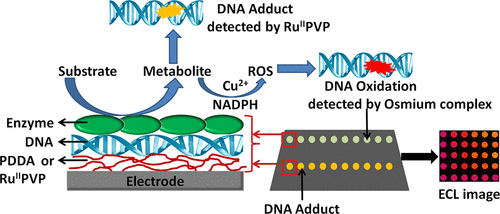当前位置:
X-MOL 学术
›
Anal. Chem.
›
论文详情
Our official English website, www.x-mol.net, welcomes your feedback! (Note: you will need to create a separate account there.)
Evaluating Metabolite-Related DNA Oxidation and Adduct Damage from Aryl Amines Using a Microfluidic ECL Array
Analytical Chemistry ( IF 7.4 ) Pub Date : 2017-11-09 00:00:00 , DOI: 10.1021/acs.analchem.7b03528 Itti Bist , Snehasis Bhakta , Di Jiang , Tia E. Keyes 1 , Aaron Martin 1 , Robert J. Forster 1 , James F. Rusling 2, 3
Analytical Chemistry ( IF 7.4 ) Pub Date : 2017-11-09 00:00:00 , DOI: 10.1021/acs.analchem.7b03528 Itti Bist , Snehasis Bhakta , Di Jiang , Tia E. Keyes 1 , Aaron Martin 1 , Robert J. Forster 1 , James F. Rusling 2, 3
Affiliation

|
Damage to DNA from the metabolites of drugs and pollutants constitutes a major human toxicity pathway known as genotoxicity. Metabolites can react with metal ions and NADPH to oxidize DNA or participate in SN2 reactions to form covalently linked adducts with DNA bases. Guanines are the main DNA oxidation sites, and 8-oxo-7,8-dihydro-2-deoxyguanosine (8-oxodG) is the initial product. Here we describe a novel electrochemiluminescent (ECL) microwell array that produces metabolites from test compounds and measures relative rates of DNA oxidation and DNA adduct damage. In this new array, films of DNA, metabolic enzymes, and an ECL metallopolymer or complex assembled in microwells on a pyrolytic graphite wafer are housed in dual microfluidic chambers. As reactant solution passes over the wells, metabolites form and can react with DNA in the films to form DNA adducts. These adducts are detected by ECL from a RuPVP polymer that uses DNA as a coreactant. Aryl amines also combine with Cu2+ and NADPH to form reactive oxygen species (ROS) that oxidize DNA. The resulting 8-oxodG was detected selectively by ECL-generating bis(2,2′-bipyridine)-(4-(1,10-phenanthrolin-6-yl)-benzoic acid)Os(II). DNA/enzyme films on magnetic beads were oxidized similarly, and 8-oxodG determined by LC/MS/MS enabled array standardization. The array limit of detection for oxidation was 720 8-oxodG per 106 nucleobases. For a series of aryl amines, metabolite-generated DNA oxidation and adduct formation turnover rates from the array correlated very well with rodent 1/TD50 and Comet assay results.
中文翻译:

使用微流控ECL阵列评估代谢产物相关的DNA氧化和芳胺的加合物损害
药物和污染物代谢产物对DNA的损害构成了人类主要的毒性途径,称为基因毒性。代谢物可与金属离子和NADPH反应以氧化DNA或参与S N2个反应,与DNA碱基形成共价连接的加合物。鸟嘌呤是DNA的主要氧化位点,最初的产物是8-oxo-7,8-dihydro-2-deoxyguanosine(8-oxodG)。在这里,我们描述了一种新型的电化学发光(ECL)微孔阵列,该阵列可从测试化合物产生代谢产物,并测量DNA氧化和DNA加合物破坏的相对速率。在这个新阵列中,DNA,代谢酶和ECL金属聚合物或复合物的膜组装在热解石墨晶片上的微孔中,被容纳在双微流体腔室中。当反应物溶液通过孔时,代谢物形成并可以与膜中的DNA反应形成DNA加合物。这些加合物通过ECL从使用DNA作为共反应剂的RuPVP聚合物中检测到。芳胺也与Cu 2+结合和NADPH形成氧化DNA的活性氧(ROS)。通过产生ECL的双(2,2'-联吡啶)-(4-(1,10-菲咯啉-6-基)-苯甲酸)Os(II)选择性检测生成的8-oxodG。相似地氧化磁珠上的DNA /酶膜,并通过LC / MS / MS确定的8-oxodG使阵列标准化。氧化检测的阵列极限是每10 6个核碱基720个8-oxodG 。对于一系列芳基胺,代谢物生成的DNA氧化和阵列中加合物形成的转化率与啮齿动物1 / TD 50和Comet分析结果非常相关。
更新日期:2017-11-09
中文翻译:

使用微流控ECL阵列评估代谢产物相关的DNA氧化和芳胺的加合物损害
药物和污染物代谢产物对DNA的损害构成了人类主要的毒性途径,称为基因毒性。代谢物可与金属离子和NADPH反应以氧化DNA或参与S N2个反应,与DNA碱基形成共价连接的加合物。鸟嘌呤是DNA的主要氧化位点,最初的产物是8-oxo-7,8-dihydro-2-deoxyguanosine(8-oxodG)。在这里,我们描述了一种新型的电化学发光(ECL)微孔阵列,该阵列可从测试化合物产生代谢产物,并测量DNA氧化和DNA加合物破坏的相对速率。在这个新阵列中,DNA,代谢酶和ECL金属聚合物或复合物的膜组装在热解石墨晶片上的微孔中,被容纳在双微流体腔室中。当反应物溶液通过孔时,代谢物形成并可以与膜中的DNA反应形成DNA加合物。这些加合物通过ECL从使用DNA作为共反应剂的RuPVP聚合物中检测到。芳胺也与Cu 2+结合和NADPH形成氧化DNA的活性氧(ROS)。通过产生ECL的双(2,2'-联吡啶)-(4-(1,10-菲咯啉-6-基)-苯甲酸)Os(II)选择性检测生成的8-oxodG。相似地氧化磁珠上的DNA /酶膜,并通过LC / MS / MS确定的8-oxodG使阵列标准化。氧化检测的阵列极限是每10 6个核碱基720个8-oxodG 。对于一系列芳基胺,代谢物生成的DNA氧化和阵列中加合物形成的转化率与啮齿动物1 / TD 50和Comet分析结果非常相关。



























 京公网安备 11010802027423号
京公网安备 11010802027423号